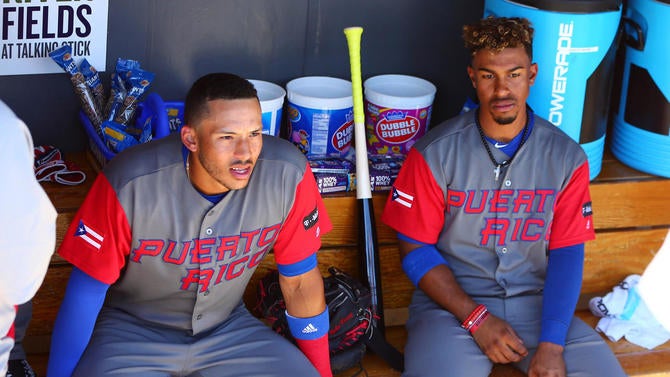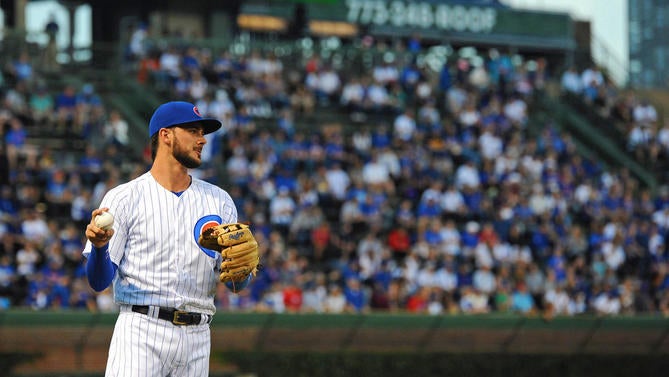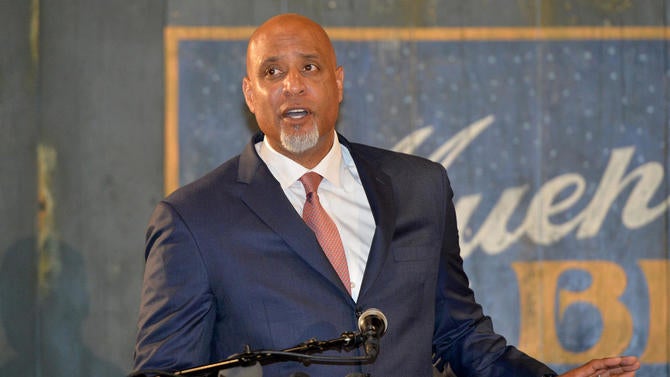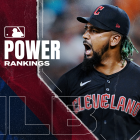Major League Baseball is broken. At least economically.
We are now in mid-January and only eight -- eight! -- of the top 20 free agents have signed new contracts. Only two of the top 10 have signed. At this point it feels like all 30 front offices are engaged in a game of chicken. Who will blink first and make their team better by signing a quality free agent?
There is no shortage of potential explanations why this offseason is moving so slow. Teams are colluding. The free-agent class kind of stinks. The new luxury tax penalties are so harsh they effectively act as a salary cap. Teams realize big-money deals for players over 30 are a bad idea. Those are all possible explanations. (Do we really think a bunch of Ivy League-educated executives just now realizing paying big money to players over 30 is a bad idea?)
Rarely can situations like this be explained by one thing. It's often a combination of many factors. But, in my opinion, this all boils down to one overriding factor: MLB teams are obsessed with young players. And understandably so. They're dirt cheap and they're often more productive than their veteran counterparts. The numbers do not lie. Look at how many plate appearances have gone to players age 30-plus over the years:
- 2000: 44.9 percent
- 2010: 40.9 percent
- 2017: 37.3 percent
Innings pitched by players age 30-plus has dropped from 40.2 percent in 2000 to 35.1 percent in 2017. Baseball is a young man's game. That has never been more true throughout baseball history than it is right now. Teams value young players so highly that they have more or less passed on quality veterans this offseason. That should scare the heck out of the MLB Players Association.
Earlier this week Jeff Passan of Yahoo! Sports wrote a great piece tackling MLB's broken economic system, and within his article are two revealing quotes:
"I'm just not sure that the structure that's been in place for all of these years makes sense anymore," one union official said. "Now, whether anybody is prepared to blow that up is a completely different question."
"Of course it doesn't make sense," a league official concurred. "We pay you the minimum for three years and arbitration for three or four years, and then you get paid more in free agency for your decline?"
The best way to fix MLB's broken economic system? Pay young players more money. It's pretty simple. Pay players more money early in their careers and two things will happen. One, they'll be less likely to sign long-term extensions because they'll already have some level of financial security, thus leading to better free-agent classes. And two, teams will look at free agents as similarly priced alternatives to young players.
How do you go about paying young players more money? MLB and the owners won't do it out of the kindness of their hearts. The MLBPA will have to push for some measures to be added to the next collective bargaining agreement to ensure those young players see a pay increase. Here are some ideas on how that can happen.
Raise the minimum salary

Straightforward enough, right? Players with less than three full years of service time are paid something close to the league minimum. Most teams have a sliding salary scale based on service time, with escalators for All-Star Games and awards finishes, things like that, but players in their pre-arbitration years are making mid-six-figures. That's nothing in baseball.
Here, for reference, are the minimum salaries set by the current CBA.
- 2017: $535,000
- 2018: $545,000
- 2019: $555,000
- 2020 and 2021: Cost of living increases only
Given how much teams value young players now, the MLBPA would be wise to seek a minimum salary north of $1 million. Start by asking for, say, $1.5 million and settle at $1 million. Teams are building around these young players and they're being asked to handle a lot of responsibility. Lead the rotation, anchor the middle of the lineup, etc. So, then, increase the league minimum substantially so they're compensated more along the lines of their actual value.
Increase amateur spending
Non-40-man roster players are not MLBPA members and thus the union has negotiated away the rights of amateur players for years to make gains elsewhere. They were easy concessions to make. Give the owners what they want on the amateur side and they'll give you something in return for 40-man roster players.
Because of that, MLB now has a hard cap for international spending and soft cap for draft spending with penalties so harsh it might as well be a hard cap. Here is how MLB's amateur spending system has evolved (devolved?) over the past two CBAs.
CBA Term | Draft Spending | International Spending |
2007-11 | Unlimited | Unlimited |
2012-16 | Soft cap with harsh penalties for excess spending | Soft cap with harsh penalties for excess spending |
2017-21 | Soft cap with harsh penalties for excess spending | Hard cap based on market size |
The earning potential of amateur players is now capped. These are the players teams are building around! They're loath to surrender draft picks to sign qualified free agents and they work as hard as possible to acquire international talent each year.
MLB teams have become quite good at developing talent as well. That's why players like Kris Bryant, Alex Bregman, Kyle Schwarber, Aaron Nola, Michael Conforto and others were able to go from top draft picks to impact MLB players in such a short period of time. And yet, the union doesn't think it is worth fighting for their rights as future union members.
In a perfect world, MLB would go back to having unlimited spending caps for draft and international talent. Better yet, abolish the draft and let prospects shop their services to the highest bidder, like non-athletes can do when they graduate college. Abolishing the draft will never ever happen, so the next best thing is letting teams spend as much as they want on amateur players. Teams value these young players so much nowadays. Make sure they pay top dollar to acquire them.
Restricted free agency
Travis Sawchik of FanGraphs first mentioned the idea of restricted free agency earlier this month. Once upon a time, during the 1994 work stoppage, MLB and the MLBPA did discuss a restricted free agency system, but the two sides shelved talks in an effort to get a deal done to resume playing.
Generally speaking, MLB's salary structure works like this, and has for years now:
- 1-3 years of service time: No arbitration rights
- 3-6 years of service time: Arbitration rights
- 6+ years of service time: Eligible for free agency
A restricted free agency system could replace those arbitration rights. Once they have more than three years of service time, players become free agents eligible to negotiate with any team. However, the player's former team has the right to match any contract offer and retain the player.
An example: Bryant was eligible for arbitration for the first time this year, and signed for a record $10.85 million. With restricted free agency, Bryant could have shopped his services to all 30 teams, which I have to think would have resulted in a $300 million offer. Maybe even $400 million. Bryant could accept that $300 million offer from whichever team, and the Cubs would then have to decide whether to match the offer to retain him, or let him go. (They would match, of course.)

Bryant is an outlier given his résumé. He would cash in huge. But lesser players would also stand to make more money through restricted free agency. How much would a top reliever like, say, Ken Giles or Corey Knebel get as a restricted free agent in today's bullpen-happy market? More than they're getting through arbitration, for sure. Even role players like Wilmer Flores and Jurickson Profar would be in better position to cash in through restricted free agency than arbitration.
Again, teams are building their rosters around young players now, so the MLBPA should want those young players to make as much money as possible. Restricted free agency makes it more expensive to keep them. It would help get them paid closer to their actual worth.
Set a free agency age
It takes six full seasons of service time to be eligible for free agency, though given how teams manipulate callups nowadays, it is often closer to seven full seasons. Bryant, for example, will have six full years plus two weeks short of a seventh full year of service time when he qualifies for free agency given the timing of his callup.
Because it takes at least six full years to become a free agent, most players are hitting the open market in their early 30s. There are a lucky few each offseason, like Eric Hosmer and Mike Moustakas this offseason and Bryce Harper and Manny Machado next offseason, who reach free agency in their 20s. The 20s are prime years, baby. Those are the years teams want.
Getting paid big as an over-30 free agent is not easy, as this offseason has shown. Teams are outright refusing to sign guys on the wrong side of 30. So, in an effort to eliminate that -- as well as combat service-time manipulation -- the MLBPA could push for a uniform free agency date. Players become a free agent at that age or after six years of service time, whatever comes first.
What's an appropriate free-agency age? I say 28. The union could start by asking for a free agency age of 27, the owners will say no way and counter with 30, then the two sides meet in the middle somewhere. That would be the best possible scenario. This way players are hitting free agency in their prime, when their earning potential is much higher than it would be in their 30s (even their early 30s).
Set a payroll floor
This is tricky, because once you start talking about a payroll floor, the owners are going to want a payroll cap. Salary caps are bad for players. The union shouldn't want any part of a mechanism that restricts the earning potential of major-league players. But, a salary floor is a potential solution to the problems we're seeing this offseason. Tie the floor to league revenues -- set the floor at some percentage of revenue to make sure the players get their piece of the pie -- so this way players know teams are spending what they should be.
Perhaps a more realistic solution is tying the luxury tax threshold to revenues. Here are the luxury tax thresholds set by the current CBA:
- 2017: $195 million
- 2018: $197 million
- 2019: $206 million
- 2020: $209 million
- 2021: $210 million
An increase of $15 million across five years. Meanwhile, MLB's revenues have increased by approximately $2.5 billion over the past five years. As Nathaniel Grow of FanGraphs explained a few years ago, a much smaller percentage of MLB's revenues are going to the players these days than around the turn of the century. Fixing that should be the union's top priority. Setting the luxury tax threshold -- or, ideally, a payroll floor -- at some percentage of league revenues would help.
Can this be accomplished without a work stoppage?

Obvious statement is obvious: No one wants a work stoppage. The players want to play, the owners want players playing, and of course fans want games to be played. Baseball has enjoyed 22 consecutive years of labor peace since the 1994-95 strike. That's great. Everyone wants baseball to be played.
That said, the owners have a pretty sweet setup right now. The cost to acquire amateur talent is low, players are cheap during what are typically the most productive years of their careers and the luxury-tax system helps cap total spending. Most owners want two things: They want to win and they want to keep costs down. Do both and you're hailed as a genius.
Because the owners have such a favorable economic setup -- the MLBPA has only itself to blame for this, it agreed to the terms in the CBA -- making any of the changes laid out above to get young players more money will be awfully tough for the union. The owners have no reason to cave. Are the players willing to strike to get what they want?
The current CBA does not expire until December 2021, so we're a long way away from serious talk about a work stoppage. Clearly though, MLB's economic system favors the owners, not the players. Just look at the current free-agent market. Some of the very best players in the game have been unable to find a job with less than a month to go until spring training.
Quality young players are gold in today's game. Teams are smart to build around them. It's not a coincidence so many recent World Series champions were built around an excellent young core. And because young players are valued so highly, the MLBPA should work to make sure those young players are fairly compensated. That is the single best thing the union can do to fix the game's broken salary structure.


















